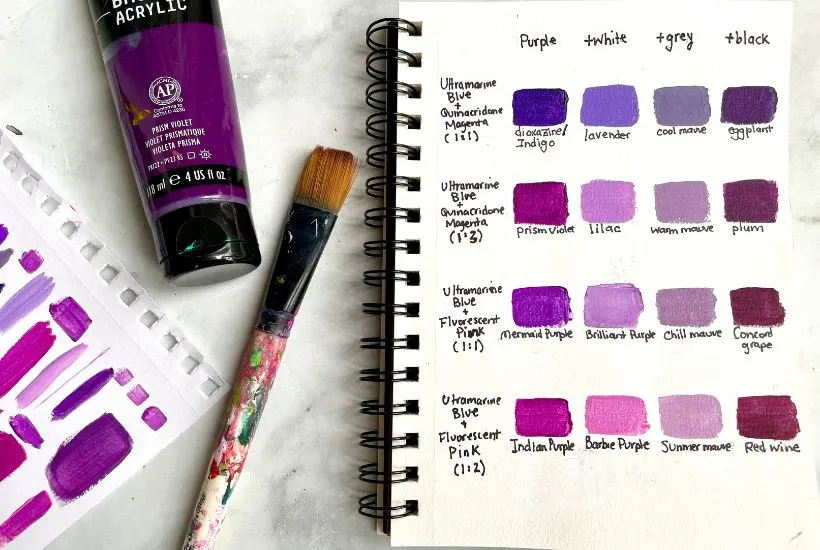How to Make Purple Paint: A Comprehensive Guide
Purple is a beautiful and versatile color that can be created by mixing various shades of red and blue paint. Whether you’re an artist looking to expand your color palette or a hobbyist wanting to create unique artwork, learning how to mix purple paint can be a valuable skill. In this comprehensive guide, we’ll explore the different techniques and methods for creating various shades of purple, from vibrant and bold to muted and pastel.
Understanding the Color Wheel
Before we dive into the specifics of mixing purple paint, it’s essential to understand the basics of color theory. The color wheel is a visual representation of how colors relate to one another. It consists of three primary colors (red, yellow, and blue), three secondary colors (orange, green, and purple), and six tertiary colors (red-orange, yellow-orange, yellow-green, blue-green, blue-violet, and red-violet).When mixing colors, it’s important to consider the temperature of the colors you’re using. Red and blue are considered cool colors, while yellow is a warm color. Mixing a cool red (like crimson) with a warm blue (like ultramarine) will create a more vibrant purple, while mixing a warm red (like cadmium red) with a cool blue (like phthalocyanine blue) will result in a more muted, grayish purple.
Mixing a True Purple
To create a true purple, you’ll need to mix equal parts of a cool-toned red and a warm-toned blue. Here’s how to do it:
- Squeeze out a small amount of a cool-toned red paint, such as permanent rose or quinacridone magenta, onto your palette.
- Next, add an equal amount of a warm-toned blue paint, such as ultramarine blue or phthalocyanine blue.
- Using a clean palette knife or brush, mix the two colors together until you achieve a rich, vibrant purple.
- If the mixture appears too blue, add a small amount of red. If it’s too red, add a touch of blue.
- Once you’re satisfied with the color, you can use it in your artwork.
Creating Darker and Muted Purples
To create darker and more muted shades of purple, you can add small amounts of black or complementary colors (colors opposite each other on the color wheel) to your mixture. Here are a few examples:
- Eggplant Purple: Mix quinacridone magenta with a small amount of ultramarine blue and a touch of black.
- Indigo: Start with a base of ultramarine blue and add a small amount of permanent rose or alizarin crimson. Then, add a tiny bit of black to darken the color.
- Muted Lavender: Mix permanent rose with a touch of ultramarine blue and a small amount of yellow ochre or raw umber.
- Dusky Purple: Begin with a mixture of quinacridone magenta and phthalocyanine blue. Then, add a small amount of yellow ochre or cadmium yellow light to mute the color.
Mixing Light and Pastel Purples
To create lighter and more pastel shades of purple, you’ll need to add white paint to your mixture. Here’s how:
- Start with a base of your desired purple, such as a mixture of permanent rose and ultramarine blue.
- Add a small amount of white paint and mix well. The more white you add, the lighter and more pastel the color will become.
- If the mixture appears too blue, add a touch of red. If it’s too red, add a bit of blue.
- Experiment with different ratios of purple to white to achieve your desired shade.
Some examples of light and pastel purples include:
- Lavender: Mix permanent rose with ultramarine blue and a generous amount of white.
- Lilac: Start with a mixture of quinacridone magenta and phthalocyanine blue, then add a significant amount of white.
- Periwinkle: Mix ultramarine blue with a small amount of permanent rose and a large quantity of white.
Enhancing Vibrancy with Complementary Colors
To make your purple paint “pop” and appear more vibrant, you can use the power of complementary colors. Complementary colors are those that sit opposite each other on the color wheel, such as yellow and purple.By adding a small amount of a yellow paint, such as cadmium yellow light or lemon yellow, to your purple mixture, you can create a more intense and vibrant shade. This works because yellow is a complementary color to purple, and the two colors create a high-contrast combination that makes the purple appear more vivid.Be careful not to add too much yellow, as it can quickly turn your purple into a muddy brown. Start with a tiny amount and gradually increase until you achieve the desired level of vibrancy.
Experimenting with Different Brands and Mediums
It’s important to note that the specific colors you use can vary depending on the brand and type of paint you’re working with. Some brands may have slightly different formulations or pigment mixes, which can affect the resulting color.Additionally, the type of paint medium you’re using (acrylic, oil, watercolor, etc.) can also influence the final outcome. Acrylics tend to be more opaque and vibrant, while watercolors are more transparent and delicate.To ensure consistent results, it’s recommended to use the same brand and type of paint throughout your mixing process. If you’re working with different brands or mediums, make sure to test them out on a separate surface before applying them to your final artwork.
Storing and Maintaining Purple Paint
Once you’ve mixed your desired shade of purple paint, it’s important to store it properly to maintain its quality and prevent it from drying out. Here are some tips:
- Transfer the paint to an airtight container, such as a small jar or tube, to minimize exposure to air.
- If using acrylic paint, add a few drops of acrylic medium or water to the container to prevent the paint from drying out.
- For oil paints, add a small amount of linseed oil or medium to the container to keep the paint fresh.
- Store the container in a cool, dry place away from direct sunlight or heat sources.
- When ready to use the paint again, stir it well with a clean palette knife or brush to reincorporate any separated pigments.
Troubleshooting Common Issues
While mixing purple paint can be a fun and rewarding experience, there are a few common issues you may encounter along the way. Here are some solutions to help you overcome them:
- Muddy or Dull Purple: If your purple appears too dull or muddy, it may be due to using the wrong combination of red and blue. Make sure you’re using a cool-toned red and a warm-toned blue for the most vibrant results. You can also add a small amount of white or yellow to brighten the color.
- Inconsistent Results: If you’re having trouble achieving the same shade of purple consistently, it may be due to variations in paint brands, mediums, or mixing techniques. Try to use the same materials and methods each time, and keep track of the specific colors and ratios you use.
- Unwanted Undertones: If your purple has unwanted undertones of red or blue, you can neutralize them by adding a small amount of the complementary color. For example, if your purple has a reddish tint, add a touch of green. If it has a bluish tint, add a small amount of orange.
- Difficulty Controlling Transparency: Transparent paints, such as watercolors, can be challenging to control when mixing purple. To achieve more opaque results, consider adding a small amount of white paint or using a thicker application of the paint.
FAQ
- What colors make purple?
- To make purple, you need to mix a cool-toned red (like crimson or quinacridone magenta) with a warm-toned blue (like ultramarine or phthalocyanine blue).
- How do I make a vibrant purple?
- For a vibrant purple, use a cool-toned red and a warm-toned blue in equal parts. You can also add a small amount of a complementary color, like yellow, to make the purple “pop.”
- Can I make purple with just red and blue paint?
- Yes, you can make a basic purple by mixing red and blue paint. However, for the most vibrant and consistent results, it’s best to use a cool-toned red and a warm-toned blue.
- How do I make a lighter or pastel purple?
- To make lighter or pastel shades of purple, add white paint to your purple mixture. The more white you add, the lighter and more pastel the color will become.
- What’s the difference between mixing purple with acrylics and oils?
- Acrylic paints tend to be more opaque and vibrant, while oil paints are more transparent and blend more easily. The specific mixing techniques and ratios may vary slightly between the two mediums.
- How do I store mixed purple paint?
- Store mixed purple paint in an airtight container, such as a small jar or tube, to minimize exposure to air. Add a few drops of medium or oil to prevent the paint from drying out, and store it in a cool, dry place away from direct sunlight or heat sources.
- Can I mix purple with other colors to create different shades?
- Yes, you can mix purple with other colors to create a wide range of shades. For example, adding white will create lighter pastel purples, while adding black or complementary colors like yellow will create darker, muted shades.
- How do I make purple paint more opaque?
- To make purple paint more opaque, you can add a small amount of white paint or use a thicker application of the paint. This is especially helpful when working with transparent mediums like watercolors.
- What should I do if my purple paint looks muddy or dull?
- If your purple paint appears muddy or dull, try adjusting the ratio of red to blue in your mixture. Make sure you’re using a cool-toned red and a warm-toned blue for the most vibrant results. You can also add a small amount of white or yellow to brighten the color.
- Can I use different brands of paint when mixing purple?
- While you can use different brands of paint when mixing purple, it’s best to use the same brand and type of paint throughout your mixing process for consistent results. Different brands may have slightly different formulations or pigment mixes, which can affect the final color.
Conclusion
Mixing purple paint can be a fun and rewarding experience, allowing you to create a wide range of shades and tones for your artwork. By understanding the basics of color theory, experimenting with different combinations of red and blue, and using complementary colors to enhance vibrancy, you can master the art of mixing purple paint. Remember to always test your colors on a separate surface before applying them to your final artwork, and store your mixed paint properly to maintain its quality and freshness.Happy painting!
References
- Mixing Purple Paint: A Comprehensive Guide
- How to Mix Purple Paint: A Step-by-Step Guide
- The Science of Mixing Purple Paint
- Color Theory: Understanding the Color Wheel
- Storing and Maintaining Acrylic Paint
| Color Mixing Ratio | Resulting Purple Shade | Example Paint Colors |
|---|---|---|
| Equal parts red and blue | True purple | Quinacridone Magenta + Ultramarine Blue |
| More blue than red | Bluer purple | Permanent Rose + Phthalocyanine Blue |
| More red than blue | Redder purple | Alizarin Crimson + Cerulean Blue |
| Red + blue + white | Light pastel purple | Permanent Rose + Ultramarine Blue + Titanium White |
| Red + blue + black | Dark, muted purple | Quinacridone Magenta + Prussian Blue + Mars Black |
| Red + blue + yellow | Muted, earthy purple | Alizarin Crimson + Phthalo Blue + Cadmium Yellow Light |



